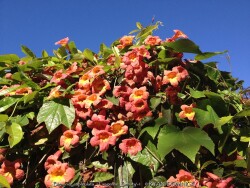

Crossvine (Bignonia capreolata) is a highly ornamented evergreen vine native to the southeast west to Oklahoma and Texas. Fantastic blooms completely cover the plant and occur on old wood in the late spring for about 3-5 weeks then sporadically during the summer. Flowers are trumpet-shaped, orange and red with yellow throats. Although in the same family as trumpet vine (campus radicans), crossvine is not invasive. Plant crossvine on fences or pergolas where you want good coverage but not anything sprawling too far away from the structure needing pruning. Considered to be one of the lowest maintenance of all vines. Crossvine prefer for part to full sun on in medium to rich soils and are able to tolerate drought and brief flooding once established. There are no serious pests or diseases to worry about. Crossvine has thrived in our Lawrence Kansas zone 6a display garden for over 15 years enduring a few occasions of -10° or colder winters. Winter foliage turns purple and remains evergreen till about -10. We have seen -18° without any dieback on the vine other than the loss of foliage that year. This great vine has it all, beautiful flowers, evergreen foliage, and constrained growth habit! Bignonia capreolata 'Tangerine Beauty' is noted for its tangerine flowers and slightly improved cold hardiness.
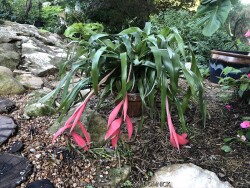

Billbergia Bromeliad / Friendship Plant (Tropical), is also known as Billbergia nutans
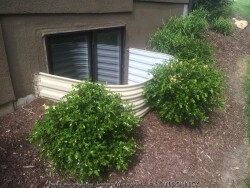

Boxwood (Buxus sp.) is a compact evergreen shrub with small round glossy green leaves. Originating in England and parts of Europe, there are many varieties ranging from small shrubs to small trees. Boxwood varieties grow rather slowly and lend themself excellently to being pruned into hedges as long as not too much is taken off at one time. After a plant achieves a certain height, you may keep it that size indefinitely with 3 to 4 times per year pruning. Boxwoods prefer part shade with rich to average well-drained soil and average moisture. Boxwoods planted in the full sun will survive but develop an burnt yellowish green color when temperatures exceed 100°F. This is usually a problem in zone 6 or further south as there are many better choices for full sun. (morning sun is okay) In zones 4-5, afternoon full sun is probably okay. Boxwoods are best known for their tolerance to dry shade even under root bound conditions. They will not survive more than a couple years under a roof overhang due to lack of moisture in the winter and spider mite problems. In the Eastern and Southeastern United States, Boxwoods have many problems including root rot, insect and disease issues. None of these are a problem in Kansas or Oklahoma with lower rainfall amounts and less humidity. In the landscape, yews offer a year-round structure. They definitely help provide a background for more interesting plants with colorful foliage and flowers. They are also very well known and used in formal garden designs. We prefer to see them less pruned and in their more natural state. Emerald Jewel Boxwood (Buxus microphylla var. koreana 'Emerald Jewel') has improved shinier light green spring foliage darkening by summer. Foliage maintains a "better" green in winter compared to other varieties. There is also no die back or twig blight problems like with Green Velvet Boxwood.
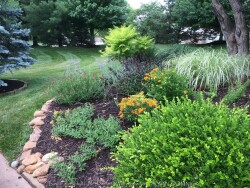

Boxwood (Buxus sp.) is a compact evergreen shrub with small round glossy green leaves. Originating in England and parts of Europe, there are many varieties ranging from small shrubs to small trees. Boxwood varieties grow rather slowly and lend themself excellently to being pruned into hedges as long as not too much is taken off at one time. After a plant achieves a certain height, you may keep it that size indefinitely with 3 to 4 times per year pruning. Boxwoods prefer part shade with rich to average well-drained soil and average moisture. Boxwoods planted in the full sun will survive but develop an burnt yellowish green color when temperatures exceed 100°F. This is usually a problem in zone 6 or further south as there are many better choices for full sun. (morning sun is okay) In zones 4-5, afternoon full sun is probably okay. Boxwoods are best known for their tolerance to dry shade even under root bound conditions. They will not survive more than a couple years under a roof overhang due to lack of moisture in the winter and spider mite problems. In the Eastern and Southeastern United States, Boxwoods have many problems including root rot, insect and disease issues. None of these are a problem in Kansas or Oklahoma with lower rainfall amounts and less humidity. In the landscape, yews offer a year-round structure. They definitely help provide a background for more interesting plants with colorful foliage and flowers. They are also very well known and used in formal garden designs. We prefer to see them less pruned and in their more natural state. Wintergreen Boxwood (Buxus microphylla var. koreana 'Wintergreen') has improved shinier light green spring foliage darkening by summer. Foliage maintains a "better" green in winter compared to other varieties. There is also no die back or twig blight problems like with Green Velvet Boxwood.
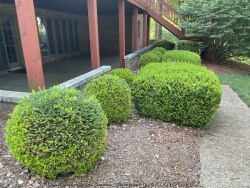

Boxwood (Buxus sp.) is a compact evergreen shrub with small round glossy green leaves. Originating in England and parts of Europe, there are many varieties ranging from small shrubs to small trees. Boxwood varieties grow rather slowly and lend themself excellently to being pruned into hedges as long as not too much is taken off at one time. After a plant achieves a certain height, you may keep it that size indefinitely with 3 to 4 times per year pruning. Boxwoods prefer part shade with rich to average well-drained soil and average moisture. Boxwoods planted in the full sun will survive but develop an burnt yellowish green color when temperatures exceed 100°F. This is usually a problem in zone 6 or further south as there are many better choices for full sun. (morning sun is okay) In zones 4-5, afternoon full sun is probably okay. Boxwoods are best known for their tolerance to dry shade even under root bound conditions. They will not survive more than a couple years under a roof overhang due to lack of moisture in the winter and spider mite problems. In the Eastern and Southeastern United States, Boxwoods have many problems including root rot, insect and disease issues. None of these are a problem in Kansas or Oklahoma with lower rainfall amounts and less humidity. In the landscape, yews offer a year-round structure. They definitely help provide a background for more interesting plants with colorful foliage and flowers. They are also very well known and used in formal garden designs. We prefer to see them less pruned and in their more natural state.
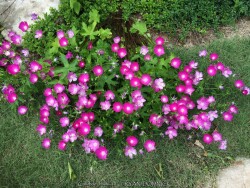

Upright Winecups (Callirhoe bushii) is also called Bush's Poppy Mallow. This plant grows from a carrot like taproot sporting a cluster of semi evergreen foliage around the base. In spring, new upright and prostrate growing vines spread in all directions along the ground up to 3 to 4 feet away from the taproot but do not root along the way. By late May or early June, magenta red "wine cup" shaped flowers cover this plant. The show last for about 4 to 6 weeks or until severe summer drought sets in. Usually in July, the flowering is complete and will set seed if allowed. Foliage will look bedraggled enough to justify complete cut back. This may be a good time to mulch unless you already mulched during the spring. When cooler weather returns in the fall, new growth emerges from the taproot looking attractive again. Secondary flowering may also occur in early fall.especially on summer planted plants. Bush's Poppy Mallow is a rare native wildflower of Missouri, Kansas, Arkansas and Oklahoma in rocky open woods and ravine bottoms. Bush's Poppy Mallow appreciates well drained soil and full to part sun. However we have found that it will still bloom and tolerate almost full shade (just a couple hours) if needed and our 40 inches of rain per year. A great plant for the top of a retaining wall, native pollinator gardens, or to even among other perennials to provide texture and contrast. It's one Achilles' heel is rabbits. Rabbits are usually only a problem in crowded suburbs where they have a little wild vegetation to eat and no predators. Gardeners with lots of established plants usually do not have rabbit problems. If rabbits are a problem for you, and you still want to grow upright wine cups, cover the plant with a bowl shaped piece of chicken wire attached with weed barrier pins. This will allow the taproot and basil foliage to get established the first year without any browsing (flowers may get eaten); after removing the cage the second year, the plants will generally outgrow any rabbit browsing. Other problems could be root rot but I have generally not seen that even in clay soils in Lawrence Kansas. Self seeding should be allowed to gently occur around the base of the plant to ensure a thick groundcover; these plants tolerate crowded conditions and will not crowd each other out or need division. This is one of the most iconic and beautiful native wildflowers!
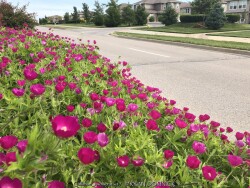

Wine cup (Callirhoe involucrata) is also called purple poppy mallow. This plant grows from a carrot like taproot sporting a cluster of semi evergreen foliage around the base. In spring, new prostrate growing vines spread in all directions along the ground up to 3 to 4 feet away from the taproot but do not root along the way. By late May or early June, magenta red "wine cup" shaped flowers cover this plant. The show last for about 4 to 6 weeks or until severe summer drought sets in. Usually in July, the flowering is complete and will set seed if allowed. Foliage will look bedraggled enough to justify complete cut back. This may be a good time to mulch unless you already mulched during the spring. When cooler weather returns in the fall, new growth emerges from the taproot looking attractive again. Secondary flowering may also occur in early fall.especially on summer planted plants. Poppy mallow winecup is a native plant of the great plains south to Texas and includes most of Kansas. As with most plants native to prairie areas, winecup appreciates well drained soil and full sun. However we have found that it will tolerate almost full shade if needed and our 40 inches of rain per year. A great plant for the top of a retaining wall, native pollinator gardens, or to even among other perennials to provide texture and contrast. It's one Achilles' heel is rabbits. Rabbits are usually only a problem in crowded suburbs where they have a little wild vegetation to eat and no predators. Gardeners with lots of established plants usually do not have rabbit problems. If rabbits are a problem for you, and you still want to grow wine cups, cover the plant with a bowl shaped piece of chicken wire attached with weed barrier pins. This will allow the taproot and basil foliage to get established the first year without any browsing; after removing the cage the second year, the plants will generally outgrow any rabbit browsing. Other problems could be root rot but I have generally not seen that even in clay soils in Lawrence Kansas. Self seeding should be allowed to gently occur around the base of the plant to ensure a thick groundcover; these plants tolerate crowded conditions and will not crowd each other out or need division. This is one of the most iconic and beautiful native wildflowers!
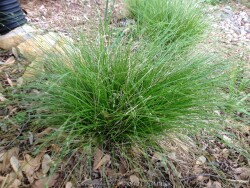

Carex appalachica, commonly called Appalachian Sedge, is native to It is native to the eastern North America, where its typical natural habitat is dry forests and woodlands. It forms a weed-suppressing grass-like clump 12" tall with brown seed heads dangling above. Bright green foliage is extremely fine-textured and hair-like. White-Tinged Sedge is one of the most drought tolerant of the sedges earning a spot in the dry shade garden; it cannot handle extreme drought or extremely rootbound soils though. Root rot can be a problem in poor drainage areas. It prefers average to dry garden conditions with dappled or morning sun. Sun burning is possible with temperatures over 100° so avoid full afternoon sun. Plantings can thrive for many years if in the right spot and there is no such thing as overcrowding. The growth rate is slow at first but eventually forms a nice weed resistant cover so space new plants relatively close together is desiring this effect.
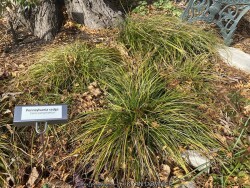

>>>>>Oak Sedge (Carex pensylvanica) is planted for its attractive grass-like green foliage>>>>>. Foliage maintains well all year provided that certain cultural conditions are met. Carex plantaginea is native to rich deciduous forests in the eastern United States up to Canada. While it excels in moist shaded sites in calcareous soils, it can adapt to difficult dry shaded sites quite well once established. If low temperatures hit 5 degrees F, foliage finally back to the ground and re-emerges in early spring. Generally this plant can decline after a few years of Kansas climate but worth a try in reasonable soils in well-tended shade gardens. Tolerates moderate dry shade with regular weeding: competition with weeds seem to be an issue in low maintenance gardens.
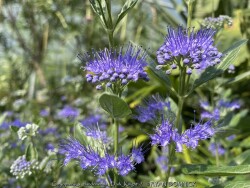

Dark Knight Caryopteris (Caryopteris x clandonensis 'Dark Knight') features darker green summer foliage followed by late-summer deep blue flowers and a compact growing habit. It adds much-needed color to the late summer landscape and makes a handsome companion with perennials. A great favorite with pollinators of all types (bees, butterflies, and hummingbirds) in the late season garden. Caryopteris demands a sunny spot and very well-drained soil. Wet soils, particularly those that remain soggy during periods of cold weather, will cause root rot. For this reason, we recommend early season planting of caryopteris in zones 5. In Eastern Kansas, this cultivar performs WELL with just about everything nature has to challenge it! Heat and drought are tolerated well. Cold tolerance is no problem for us in zone 6. Caryopteris gives great winter interest with it's dried flowers. The only maintenance this shrub needs is cutting back about 1/2 way in early spring before new growth emerges. No disease or pest problems. Great plant for berms or hot West or South exposures in full sun. Do not plant in rich moist soils or root rot will probably occur. Even when not blooming, the compact green foliage looks good on it's own or combines well with earlier season blooming red, purple, blue, or magenta flowering plants. Combine with crapemyrtles and butterflybush to create a late season "all you can eat" buffet for pollinators!
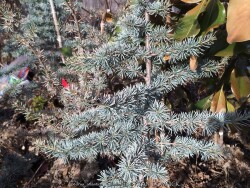

Blue Atlas Cedar (Cedrus atlantica 'Glauca') is an outstanding ornamental conifer tree with the characteristic conical shape and bluish-silver color. Foliage density is very compact along the branches but with plenty of space between branches, enough to show off the wonderful architectural branching structure of the tree. It is cold and drought tolerant enough to survive in much of Kansas with mature specimens (15-30' tall) occasionally seen in Lawrence and Kansas City. In Eastern Kansas, typically our 40 inches of rainfall is sufficient without extra water if planted in good soils. Avoid poorly drained clay soils especially that hold water for more than a day. Numerous cultivar selections are available, many for improved blue color of the needles or different growth forms. There is at least one "weeping" selection that I have witnessed prospering in Lawrence, KS for many years surviving -16 degrees F and a week of single digit highs in February, 2021.
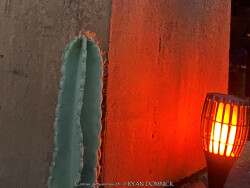

Grown for its beautiful bluish-green skin and showy night-blooming white flowers. Unlike most columnar cacti, Peruvian apple cactus (Cereus peruvianus) will bloom at a young age in a pot when about 3' tall or more. This cactus is usually grown as a patio or house plant in Kansas and blooms in late summer into early fall. Flowers only last one night! In the wild, this species is hardy to 20-25 degrees F for short periods of time. Grow in full sun with optional extra watering including that which comes from rainfall. Repotting may or may not be needed depending on how large you want the plant to grow; plants can continue to grow taller and tolerate extremely root-bound pots but may need wind bracing. If repotting, make sure to use a sharp draining medium organic cactus mix with plenty of sand and perlite. To play is safe, potted plants are best moved in before night temperatures get below 45 degrees F. It is important to avoid the combination of wet and cold. Before extreme cold occurs, move to a bright interior window over the winter with no watering and keep above freezing. As a winter house plant, it will look presentable all winter long with just no waterings. As a permanent house plant, provide bright light and allow the soil to dry between waterings for many years of carefree enjoyment. Plants grown permanently indoors may begin to elongate stretching for light producing weak new growth. It can be hard to reproduce the intense UV sunlight they need so moving outside for the summer is best. Generally if moving outside for the summer, allow 1-2 weeks of part shade or morning sun before placing in full sun. Plants with time to acclimate will thrive in full sun but be careful not to rush it or sunburning will occur. Potted plants are very low maintenance. I have never seen any insect problems on this plant. Potted plants are capable of growing 10' tall or more in a small 7gal pot.
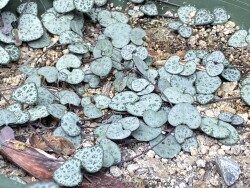

Ceropegia woodii known as the Rosary Vine and String of Hearts. This unusual, hardy vining succulent produces pretty, variegated, heart-shaped leaves with purple undersides on tough, wire-like stems. They are usually grown as a patio or house plant in Kansas. String of Hearts also grow well in hanging baskets as a durable, succulent plant able to survive drying out, heat and dry air like few others! If conditions get too rough, the foliage simply dies back and growth returns from underground tubers when favorable conditions return. To play is safe, potted plants are best moved in before night temperatures get below 45 degrees F. It is important to avoid the combination of wet and cold. Before extreme cold occurs, move to a bright interior window over the winter with no watering and keep above freezing. As a winter house plant, it will look presentable all winter long with just no waterings. As a permanent house plant, provide bright light and allow the soil to dry between waterings for many years of carefree enjoyment. Plants grown permanently indoors may begin to elongate stretching for light producing weak new growth. It can be hard to reproduce the intense UV sunlight they need so moving outside for the summer is best. Generally if moving outside for the summer, allow 1-2 weeks of part shade or morning sun before placing in full sun. Plants with time to acclimate will thrive in full sun but be careful not to rush it or sunburning will occur. Potted plants are very low maintenance. I have never seen any insect problems on this plant.
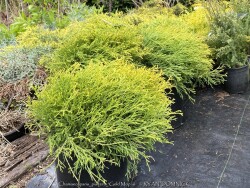

Gold Mop False Cypress (Chamaecyparis pisifera 'Gold Mop') is from a group of small coniferous shrubs from Asia with Juniper-like foliage. The foliage is bright yellow, thread-like and creates a relatively low, semi-weeping habit. It provides consistent color during spring, summer, fall, and darkens to a more gold color by winter providing excellent color when most other plants are dormant. Full sun and average garden conditions are preferred. Maintenance is pretty easy, only prune when needed to control size. Do not prune in late summer or fall. Coloring is definitely best if the plant can receive winter sun. Combine in the summer with other flowering perennials and shrubs. Combine in the winter with ornamental grasses, yuccas, Nandinas, or winter interest plants that contrast with gold.


***Description for this plant available with future update!***
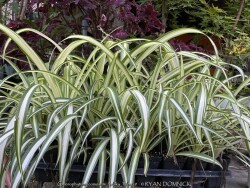

Milky Way Spider Plant (Tropical), is also known as Chlorophytum comosum 'Milky Way'
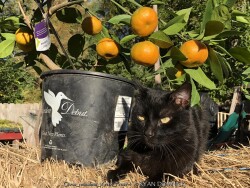

Arctic Frost Hardy Satsuma (Citrus reticulata 'Arctic Frost') is typically grown in warmer zones as far North as Dallas (Zone 8a). Along with other tropicals and succulents in Kansas, Arctic Frost is usually grown as summer patio plant and then moved inside for the winter. Move to bright area in a cold garage, basement, or window over the winter with monthly watering. During the growing season, water regularly and place in full sun. If grown in a larger 20 gallon pot or so, it may flower and fruit when 4-5 feet tall after a few years. Before hard freezes come in the fall, move inside to protect from temperatures below 25 degrees F if you want fruit. Flower buds form in the winter on citrus trees. If you want evergreen foliage, protect with anything lower than 15 degrees F. It will tolerate down to 10 degrees F with complete defoliation and around 0 degrees F with complete wood kill down to the base of the trunk. Because it is grown on its own root system, it will come back true from winter kill down to the ground. A plant in our Lawrence, KS cold frame survived 0 degrees F for a few days and grew 3-4' back the following year. Don't expect flowers and fruit in these conditions though.
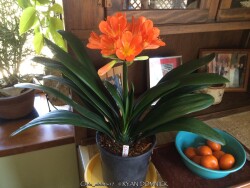

Clivia (Clivia miniata) has attractive dark green, wide, glossy, curved foliage along with long lasting bright orange flowers followed by red fruits. Also sometimes called Bush lily or Kaffir lily, it is native to seasonal semi-dry woodland habitats in South Africa. It is best used as a houseplant or full-shade summer patio plant in Kansas. Place in full shade in areas where occasional extra watering can happen including that which comes from rainfall. Repotting may or may not be needed depending on how large you want the plant to grow; plants can continue to grow thicker and tolerate extremely root-bound pots. Potted plants are hardy to at least 30 degrees F for a short time but try not to miss the first light frost. Move into a cold garage, basement, or bright window over the winter with occasional to no watering. Flowering is more reliable with root-bound plants given a cool 2-4 month dormant season with temperatures in the 40-50 degree F range with little to no winter watering. Larger plants can survive 3-5 months without water in the winter if allowed to have a healthy outdoor growing season. As a winter house plant, it will look presentable all winter long with just a few waterings. As a permanent house plant, provide bright light and allow the soil to dry between waterings for many years (even decades) of carefree enjoyment. Potted plants grow very slow and are very low maintenance needing only old leaves removed once per year. Mealy bugs can be a problem with permanent indoor house plants but will go away if grown outside during the summer or never introduced in the first place. Either way, take outside and administer sharp blasts of hose water and/or horticultural oil spray to eliminate this (only) pest problem. Note that clivia will sunburn rapidly if accidently left in full sun even for a few hours, even in cooler weather in spring or fall so be aware of its needs and protect from all direct outdoor sunlight. Indoor grown plants however, can handle direct sun (UV blocked light) from windows. Clivia is relatively rare and will command a higher price than most other houseplants.
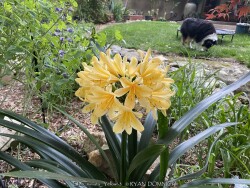

Clivia (Clivia miniata) has attractive dark green, wide, glossy, curved foliage along with long lasting bright yellow flowers followed by red fruits. Also sometimes called Bush lily or Kaffir lily, it is native to seasonal semi-dry woodland habitats in South Africa. It is best used as a houseplant or full-shade summer patio plant in Kansas. Place in full shade in areas where occasional extra watering can happen including that which comes from rainfall. Repotting may or may not be needed depending on how large you want the plant to grow; plants can continue to grow thicker and tolerate extremely root-bound pots. Potted plants are hardy to at least 30 degrees F for a short time but try not to miss the first light frost. Move into a cold garage, basement, or bright window over the winter with occasional to no watering. Flowering is more reliable with root-bound plants given a cool 2-4 month dormant season with temperatures in the 40-50 degree F range with little to no winter watering. Larger plants can survive 3-5 months without water in the winter if allowed to have a healthy outdoor growing season. As a winter house plant, it will look presentable all winter long with just a few waterings. As a permanent house plant, provide bright light and allow the soil to dry between waterings for many years (even decades) of carefree enjoyment. Potted plants grow very slow and are very low maintenance needing only old leaves removed once per year. Mealy bugs can be a problem with permanent indoor house plants but will go away if grown outside during the summer or never introduced in the first place. Either way, take outside and administer sharp blasts of hose water and/or horticultural oil spray to eliminate this (only) pest problem. Note that clivia will sunburn rapidly if accidently left in full sun even for a few hours, even in cooler weather in spring or fall so be aware of its needs and protect from all direct outdoor sunlight. Indoor grown plants however, can handle direct sun (UV blocked light) from windows. Yellow clivia is rare and will command a higher price than most other houseplants.
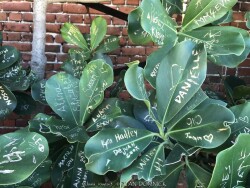

The foliage is this plant's feature characteristic with thick and leathery teardrop shaped leaves. Autograph Tree (Clusia rosea) is typically grown in warmer zones native to the Caribbean. Considered a tropical or succulent in Kansas and used as summer patio plants with white flowers and bright green foliage. Grow in full sun to part sun with optional extra watering during hot weather including that which comes from rainfall. Plants with plenty of time to acclimate will thrive in full sun but be careful not to rush it or sunburning will occur. Generally if moving outside for the summer, allow 2-3 weeks of part shade or morning sun before placing in full sun. Or just keep in part shade or under an overhang. Repotting may or may not be needed depending on how large you want the plant to grow; plants can continue to grow and tolerate extremely root-bound pots but may need wind bracing. Protect from temperatures below 45 degrees F and move into a bright window over the winter with little watering. Do not allow this plant to freeze or even get close to freezing especially if soil is wet or death may occur. As a winter house plant, it will look presentable all winter long with just a few monthly or no waterings if you forget. As a permanent house plant, provide bright light and allow the soil to dry between waterings for many years of carefree enjoyment. Potted plants are very low maintenance needing almost nothing. These shrubs are sometimes called Autograph Tree or Plant because you can scratch a name or initials onto a leaf and it will stay there forever.or as long as the leaf remains on the plant.
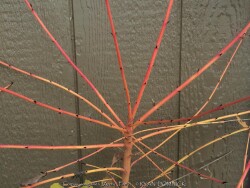

Arctic Sun® Dogwood (Cornus sanguinea 'Arctic Sun') is a new color breakthrough from Proven Winners! Set your winter landscape ablaze with color! Keep your landscape lively even in winter with the glorious yellow, orange, and coral stems of Arctic Sun® dogwood. It performs like the familiar red-twig dogwoods but with unique color that positively glows in the landscape. Tolerant of a very wide range of soil conditions and one of the best ornamental shrubs for shade, Arctic Sun dogwood is an easy choice for nearly effortless color. Top reasons to grow Arctic Sun dogwood: 1.unusual yellow, orange, and coral stems pop in the winter landscape. 2.easy to grow. 3.deer resistant and shade tolerant. Uses Notes: Beautiful in the landscape or a container to add winter interest. Stems may be cut for winter flower arrangements. Maintenance Notes: The best red color appears on one and two year old stems; older stems will turn corky and brown. To maintain a colorful display, you can do one of two things: one, cut the whole plant back to short stubs every other year. Two, cut out one-third of the oldest stems every year. This option is recommended if you planted your Arctic Fire® dogwood to provide coverage. Early spring is the best time to prune. If desired, apply a granular fertilizer formulated for trees and shrubs at pruning time. In Eastern Kansas, this cultivar performs WELL with just about everything nature has to challenge it! Heat and drought are tolerated if in shade or morning sun. Cold tolerance is no problem. No disease or pest problems. Great plant for dry-shade. After 10 years and despite a slow growth rate, it is advisable to rejuvinate this shrub down to the ground as it will reach 5-6 feet tall eventually. Especially effective against dark backgrounds! All Proven Winners® plants are legally propagated, healthy and vigorous, true to name, and tagged with color pictures and growing information.
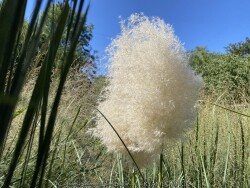

***Description for this plant available with future update!*** Cortaderia selloana 'Blue Bayou' is hardy to zone 6b.
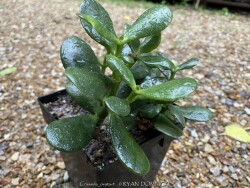

Jade Plant (Crassula ovata) is typically grown in warmer zones. Considered a tropical or succulent in Kansas and used as summer patio plants with white flowers and bright green foliage. Grow in full sun to part sun with optional extra watering during hot weather including that which comes from rainfall. Plants with plenty of time to acclimate will thrive in full sun but be careful not to rush it or sunburning will occur. Generally if moving outside for the summer, allow 2-3 weeks of part shade or morning sun before placing in full sun. Or just keep in part shade or under an overhang. Repotting may or may not be needed depending on how large you want the plant to grow; plants can continue to grow and tolerate extremely root-bound pots but may need wind bracing. Jade Plant can tolerate brief frosts but protect from temperatures below 29 degrees F for more than a few hours. As a permanent house plant, provide bright light and allow the soil to dry between waterings for many years of carefree enjoyment. Potted plants are very low maintenance but the combination of wet and cold will cause problems.
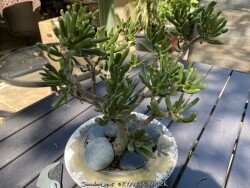

Jade Plant (Crassula ovata) is typically grown in warmer zones. Considered a tropical or succulent in Kansas and used as summer patio plants with white flowers and bright green foliage. Grow in full sun to part sun with optional extra watering during hot weather including that which comes from rainfall. Plants with plenty of time to acclimate will thrive in full sun but be careful not to rush it or sunburning will occur. Generally if moving outside for the summer, allow 2-3 weeks of part shade or morning sun before placing in full sun. Or just keep in part shade or under an overhang. Repotting may or may not be needed depending on how large you want the plant to grow; plants can continue to grow and tolerate extremely root-bound pots but may need wind bracing. Jade Plant can tolerate brief frosts but protect from temperatures below 29 degrees F for more than a few hours. As a permanent house plant, provide bright light and allow the soil to dry between waterings for many years of carefree enjoyment. Potted plants are very low maintenance but the combination of wet and cold will cause problems. The 'Hobbit' variety has an interesting mutation giving it the appearance of having its leaves rolled up and fused together. Hobbit jade (Crassula ovata 'Hobbit') is relatively rare and will command a higher price than most other houseplants.


Red Burst Bromeliad (Cryptbergia 'Red Burst') is an intergeneric bromeliad hybrid that is a cross between Billbergia nutans x Cryptanthus bahianus. It forms rosettes of flattened 8-12" long pointed green/bronzy-red leaves. Color ranges from dark green in shade to more intense maroon in bright UV light. 'Red Burst' is usually grown as a patio or house plant in Kansas. Best grown in full to part sun with some extra watering including that which comes from rainfall. Repotting may or may not be needed depending on how large you want the plant to grow; plants can continue to grow thicker and tolerate extremely root-bound pots and bone dry soil. If repotting, make sure to use a cactus mix with some of sand and perlite. Although plants are hardy to 26-28 degrees F, potted plants are best moved in before night temperatures get below 35 degrees F. It is important to avoid the combination of wet and cold. Move to a bright interior window over the winter with no watering and keep above freezing. As a winter house plant, it will look presentable all winter long with just no waterings. As a permanent house plant, provide bright light and allow the soil to dry between waterings for many years of carefree enjoyment. Plants grown permanently indoors may begin to lose foliage color. It can be hard to reproduce the intense UV sunlight they need so moving outside for the summer is best. Generally if moving outside for the summer, allow 1-2 weeks of part shade or morning sun before placing in full sun. Plants with time to acclimate will thrive in full sun but be careful not to rush it or sunburning will occur. Potted plants are very low maintenance; no pests have ever been observed on this bullet-proof plant.
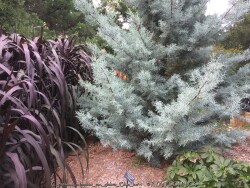

Blue Ice Arizona Cypress (Cupressus arizonica var. glabra 'Blue Ice') is a relatively new plant being used in Kansas zone 6. Originally native to desert areas of the Southwest and Mexico including dry mountain slopes, it seems pretty well adapted to our climate without many of the traditional pests that plague evergreens. Several 15-20 foot tall specimens can be observed in the Wichita botanical garden, Botanica. 'Blue Ice' Arizona Cypress is grown for its bluish nearly silver foliage, unique conical (pyramidal when young) growth form, and occasional silver fruit. Drainage definitely needs to be on the positive side but most soils seem okay. Planting on a South or West foundation is perfect. (or on a south facing berm) Extreme heat tolerance is not a problem opposed to cold-loving blue spruce. Growth is relatively fast at about 1 to 2 feet per year; also much faster than traditional blue spruce. Small established plants on a berm in Lawrence, Kansas handled the deep freeze of 2021 surviving -16 degrees F and a week of single digit highs with no damage. Definitely a plant for the future!
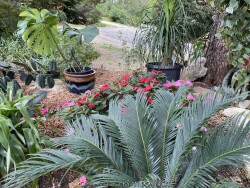

Cycad / Sago Palm (Tropical), is also known as Cycas revoluta


This upright Cholla Cactus (Cylindropuntia imbricata) features magenta flowers and upright growth form are a unique addition to the garden. Native to arid clay soils in Western Kansas, Colorado, Oklahoma and parts of the southwestern United States and Mexico, the plant grows into a vicious unforgiving shrub if you get too close. From a distance however, this cactus has a place as one of the few upright cacti that can handle extreme cold. In fact, I have seen this species growing a few times in Lawrence, KS in desert gardens and even in full (dry) shade! Flowering in shade is doubtful though. With well drained soils and proper siting, this cactus can handle our excess rainfall in Eastern Kansas.
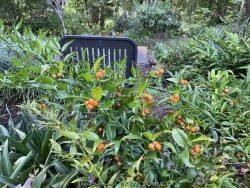

***Description for this plant available with future update!***
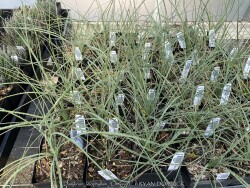

***Description for this plant available with future update!***
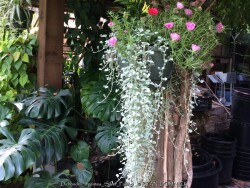

Silver Falls Dichondra / Silver Nickel Vine (Dichondra argentea 'Silver Falls') is a annual in Kansas gardens; quickly fills space providing a contrast for other flowering annuals. Vigorous, fan-shaped silver foliage grows on silver stems; very heat and drought tolerant. Very strongly trailing plant is a fun component in hanging baskets.
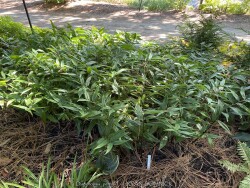

Evergreen Solomon's seal (Disporopsis pernyi) is planted for its evergreen dark green foliage and white flowers. Foliage maintains well all year provided that certain cultural conditions are met. Native to shaded mountain areas in forests, valleys or along streams in southern China, it needs constantly moist soil rich in organic matter avoiding too much clay. If low temperatures hit -10 degrees F, foliage finally dies back to the ground and re-emerges in early spring. Generally this plant can decline after a few years of Kansas climate but is worth a try in perfect soils in well-tended shade gardens. If low temperatures hit -10 degrees F, it may kill an un-mulched plant; protect any zone 6 perennial with thick layer of mulch. Lack of moisture and competition with weeds seem to be an issue but it survives just fine but never gets very dense. This is however, one of the most deep shade tolerant plants available.


Autumn Shield Fern, is also known as Dryopteris erythrosora
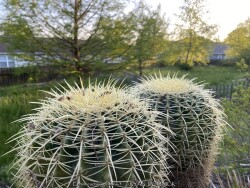

Golden Barrel Cacti (Echinocactus grusonii) are known for their bright yellow spines. Native to deserts in Mexico, it's usually grown as a patio or house plant in Kansas. In the wild, established golden barrel cacti are hardy to 13 degrees F for short periods of time. Grow in full sun with no extra watering except that which comes from rainfall. Repotting may or may not be needed depending on how large you want the plant to grow; plants can continue to grow taller and tolerate extremely root-bound pots but may need wind bracing. If repotting, make sure to use a sharp draining low organic cactus mix with plenty of sand and perlite. Potted plants are hardy to at least 25 degrees F for a short time if kept dry so you are ok if you miss the first light frost. Do not allow the pot with rootball to freeze solid though. Before extreme cold occurs, move to a bright interior window over the winter with no watering and keep above freezing. As a winter house plant, it will look presentable all winter long with just no waterings.(also to prevent soft winter growth) As a permanent house plant, provide bright light and allow the soil to dry between waterings for many years of carefree enjoyment. Plants grown permanently indoors may begin to elongate stretching for light and lose their spine color. It can be hard to reproduce the intense UV sunlight they need so moving outside for the summer is best. Generally if moving outside for the summer, allow 1-2 weeks of part shade or morning sun before placing in full sun. Plants with time to acclimate will thrive in full sun but be careful not to rush it or sunburning will occur. Potted plants are very low maintenance. I have never seen any insect problems on this plant.


Grown for its beautiful bluish-green skin and relatively few spines, San Pedro Cactus () is usually a patio or house plant in Kansas. Because it grows naturally in the Peruvian Andes Mountains at high altitude and with high rainfall, it can withstand temperatures far below that of many other cacti. In the wild, this species is hardy to 15-20 degrees F for short periods of time. Grow in full sun with optional extra watering including that which comes from rainfall. Repotting may or may not be needed depending on how large you want the plant to grow; plants can continue to grow taller and tolerate extremely root-bound pots but may need wind bracing. If repotting, make sure to use a sharp draining medium organic cactus mix with plenty of sand and perlite. To play is safe, potted plants are best moved in before night temperatures get below 45 degrees F. It is important to avoid the combination of wet and cold. Before extreme cold occurs, move to a bright interior window over the winter with no watering and keep above freezing. As a winter house plant, it will look presentable all winter long with just no waterings.(also to prevent lanky winter growth) As a permanent house plant, provide bright light and allow the soil to dry between waterings for many years of carefree enjoyment. Plants grown permanently indoors may begin to elongate stretching for light producing weak new growth. It can be hard to reproduce the intense UV sunlight they need so moving outside for the summer is best. Generally if moving outside for the summer, allow 1-2 weeks of part shade or morning sun before placing in full sun. Plants with time to acclimate will thrive in full sun but be careful not to rush it or sunburning will occur. Potted plants are very low maintenance. I have never seen any insect problems on this plant. The San Pedro cactus contains a number of alkaloids, including the well-studied chemical mescaline. In the US, it is currently legal to cultivate the San Pedro cactus for gardening and ornamental purposes, but not for consumption.
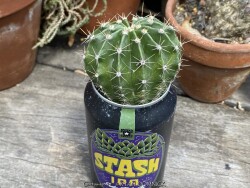

Sea Urchin Cactus (Echinopsis sp.) is a large genus of cacti native to South America, sometimes known as hedgehog cactus. Grown for its beautiful tubular flowers, it's usually a patio or house plant in Kansas. In the wild, some species are hardy to 15-20 degrees F for short periods of time. Grow in full sun with no extra watering except that which comes from rainfall. Repotting may or may not be needed depending on how large you want the plant to grow; plants can continue to grow taller and tolerate extremely root-bound pots but may need wind bracing. If repotting, make sure to use a sharp draining low organic cactus mix with plenty of sand and perlite. To play is safe, potted plants are best moved in before night temperatures get below 45 degrees F. It is important to avoid the combination of wet and cold. Before extreme cold occurs, move to a bright interior window over the winter with no watering and keep above freezing. As a winter house plant, it will look presentable all winter long with just no waterings. As a permanent house plant, provide bright light and allow the soil to dry between waterings for many years of carefree enjoyment. Plants grown permanently indoors may begin to elongate stretching for light and lose their spine color. It can be hard to reproduce the intense UV sunlight they need so moving outside for the summer is best. Generally if moving outside for the summer, allow 1-2 weeks of part shade or morning sun before placing in full sun. Plants with time to acclimate will thrive in full sun but be careful not to rush it or sunburning will occur. Potted plants are very low maintenance. I have never seen any insect problems on this plant.


>>>>>Repeated or successive cold winters with complete foliage loss seem to be an issue with this and many evergreen zone 6/7 plants. One occasional difficult winter followed by mild winters is more tolerable. This is, however, a very vigorous growing plant so generally will recover in one summer with decent watering and fertilizer.
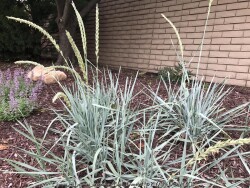

Blue Dune Lyme Grass, is also known as Elymus / Leymus arenarius 'Blue Dune'


Barrenwort (Epimedium) features compact dainty mounds of green to colored weed-resistant foliage. Wispy flowers appear above emerging foliage in mid-spring. Improved breeding has resulted in many different flower colors even including orange. Semi-evergreen foliage can sometimes look bedraggled by late summer if there is too much overhead watering and humidity. Barrenwort prefers average to dry garden conditions and even thrive and dry shade. Plantings can thrive for decades if in the right spot; there is no such thing as overcrowding for Barrenwort. When planted in mass, growth is slow at first but eventually a cake-like rhizome system will form and completely smother out any weeds and compete well with trees for water and nutrients. While barrenwort can tolerate full sun, they prefer part to full shade. Sun burning is possible with temperatures over 100° and there are better plants to use in hot areas. Due to slow spreading growth, you shouldn't leave very much room in-between barrenwort plants or you will be waiting many years for the patch to fill in. Weeds can be a problem in that open area between plants if spacing is too wide. We recommend 9-12" spacing and use for small nooks in the shade garden. If planning for a larger area, still figure on the tight spacing but allow for a higher budget that you will consider a permanent investment. Barrenwort is a real trooper for the dry shade garden!
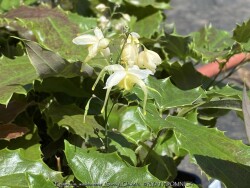

Barrenwort (Epimedium) features compact dainty mounds of green to colored weed-resistant foliage. Wispy flowers appear above emerging foliage in mid-spring. Improved breeding has resulted in many different flower colors even including orange. Semi-evergreen foliage can sometimes look bedraggled by late summer if there is too much overhead watering and humidity. Barrenwort prefers average to dry garden conditions and even thrive and dry shade. Plantings can thrive for decades if in the right spot; there is no such thing as overcrowding for Barrenwort. When planted in mass, growth is slow at first but eventually a cake-like rhizome system will form and completely smother out any weeds and compete well with trees for water and nutrients. While barrenwort can tolerate full sun, they prefer part to full shade. Sun burning is possible with temperatures over 100° and there are better plants to use in hot areas. Due to slow spreading growth, you shouldn't leave very much room in-between barrenwort plants or you will be waiting many years for the patch to fill in. Weeds can be a problem in that open area between plants if spacing is too wide. We recommend 9-12" spacing and use for small nooks in the shade garden. If planning for a larger area, still figure on the tight spacing but allow for a higher budget that you will consider a permanent investment. Barrenwort is a real trooper for the dry shade garden! Sandy Claws Barrenwort (Epimedium wushanense 'Sandy Claws') features long, lance-shaped leaves and spiny margins (not sharp). Newly emerging foliage has dramatic maroon coloring unique to the shade garden. The color mellows to dark green by summer. The cream-colored flowers contrast beautifully with the brilliantly colored foliage. Growth is faster and height is taller at 12-16" Albeit still slow compared to other perennials.
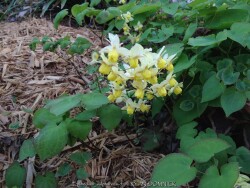

Barrenwort (Epimedium) features compact dainty mounds of green to colored weed-resistant foliage. Wispy flowers appear above emerging foliage in mid-spring. Improved breeding has resulted in many different flower colors even including orange. Semi-evergreen foliage can sometimes look bedraggled by late summer if there is too much overhead watering and humidity. Barrenwort prefers average to dry garden conditions and even thrive and dry shade. Plantings can thrive for decades if in the right spot; there is no such thing as overcrowding for Barrenwort. When planted in mass, growth is slow at first but eventually a cake-like rhizome system will form and completely smother out any weeds and compete well with trees for water and nutrients. While barrenwort can tolerate full sun, they prefer part to full shade. Sun burning is possible with temperatures over 100° and there are better plants to use in hot areas. Due to slow spreading growth, you shouldn't leave very much room in-between barrenwort plants or you will be waiting many years for the patch to fill in. Weeds can be a problem in that open area between plants if spacing is too wide. We recommend 9-12" spacing and use for small nooks in the shade garden. If planning for a larger area, still figure on the tight spacing but allow for a higher budget that you will consider a permanent investment. Barrenwort is a real trooper for the dry shade garden! Epimedium x versicolor 'Sulphureum' is a faster spreading, more robust yellow flowering variety. Albeit still very slow compared to other perennials.
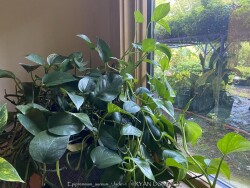

***Description for this plant available with future update!***
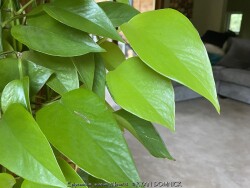

***Description for this plant available with future update!***
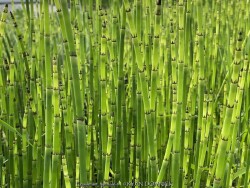

Horsetail Reed (Equisetum hyemale) is a very primitive "Dinosaur" plant with a one-of-a-kind appearance. Tube-like segmented stems grow vertical creating a dense bamboo-like appearance when grown properly in a pot or edging. The evergreen stems (down to -30 degrees F) are particularly noticeable in winter and can provide significant interest to the landscape. It is mostly used as a native erosion control plant in large areas along streams and wet wooded areas. For the home garden, the species is generally too aggressive to mix with other plants unless contained. The best use is as a marginal water garden plant in a sealed container. Horsetail rhizomes cannot spread thru open water or hop over an edge in the open air. If planted in the garden and once established, it is extremely difficult to remove by digging because its rhizomes spread wide and deep. Roundup is not effective against primitive plants such as horsetail and mosses. If planted in the garden, use professional soil barriers or no-fail sealed planters (no drainage holes ok) to restrict growth. Native to large portions of Eurasia, Canada and the U.S., including Kansas, equisetum is the single surviving genus of a class of primitive vascular plants dating back to the mid-Devonian period (350 + million years ago). As a plant evolved before twigs and leaves, Horsetail Reed is a non-flowering, seedless plant that reproduces by spores.
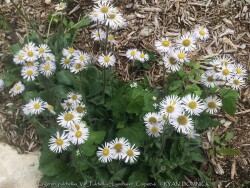

Robin's Plantain / Fleabane, is also known as Erigeron pulchellus var. pulchellus 'Lynnhaven Carpet'
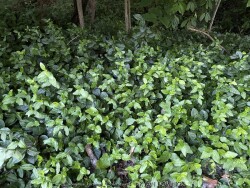

Purple Wintercreeper (Euonymus fortunei 'Coloratus') makes a durable evergreen groundcover that starts off slow, but grows quickly after a few years to forms a dense, weed-smothering mat of foliage. As one of the most dry-shade tolerant plants there is, it's thick leathery leaves seem to handle everything nature has to throw at it! That being said, beware that this is an extremely vigorous plant that crowds out most weeds and is itself weed-like, with a very spreading growth habit. After establishment, it is high maintenance if it has already filled the space and you don't want it to spread any further: it even resists Round-up! It will climb trees if you allow it, generally using it for support to allow its mature form to develop and flowering to occur. From there, red-orange seeds develop that are spread everywhere and will overrun nearby native forests in Eastern Kansas. For the home garden, the species is generally too aggressive to mix with other plants. At our plant nursery, since we cannot eradicate it, we have allowed it to cover a tall fence along the back of our property where it has crept in from the neighboring woods. It does form a nice evergreen screen as it weaves into the trees.
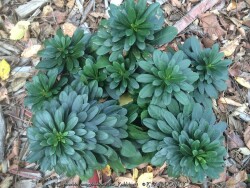

Robbie Spurge (Euphorbia amygdaloides var. robbiae) is grown for its deep green glossy whorled foliage that is very architectural and symetrical. They have everything a gardener might ask for; beautiful spring flowers, dependable dark green foliage, evergreen during winter, pest-free foliage, and ease of care with very low maintenance. Rare greenish-yellow flowers last incredibly long 1 to 2 months and finally turn brown in need of dead-heading. Native to dry woodland locations in Europe, Turkey and the Caucasus, Robbie Spurge tolerates poor soils, including rocky-sandy ones. Root rot can be a problem in poor drainage areas. It prefers average to dry garden conditions with dappled or morning sun. Sun burning is possible with temperatures over 100° so avoid full afternoon sun. Plantings can thrive for many years if in the right spot and there is no such thing as overcrowding. The growth rate is slow at first but eventually forms a nice weed resistant cover so space new plants relatively close together is desiring this effect. Evergreen foliage is hardy to about -10°F with complete death occurring at about -15°F for unmulched plants. Robbie Spurge is less adapted to consistent summer heat and humidity of zone 7b areas or South. With poisonous foliage, these plants resist deer and rabbit browsing. What a great plant for the dry shade garden!
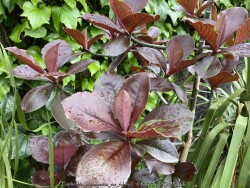

The velvety maroon foliage colors and patterns of Red-leaf African Milk Bush (Euphorbia bicompacta var. rubra) are amazing. Usually used as a patio or house plant in Kansas. Grow in full sun to full shade with optional extra watering including that which comes from rainfall. Plants with time to acclimate will thrive in full sun but be careful not to rush it or sunburning will occur. Generally if moving outside for the summer, allow 2-3 weeks of part shade or morning sun before placing in full sun. Repotting may or may not be needed depending on how large you want the plant to grow; plants can continue to grow taller and tolerate extremely root-bound pots but may need wind bracing. Potted plants are hardy to at least 25 degrees F for a short time if kept dry so you are ok if you miss the first light frost. Do not allow the pot with rootball to freeze solid though. Then move into a cold garage, basement, or bright window over the winter with occasional watering. As a winter house plant, it will look presentable all winter long with just a few waterings. As a permanent house plant, provide bright light and allow the soil to dry between waterings for many years of carefree enjoyment. Potted plants are very low maintenance needing very occasional pruning or topping. Leaves are filled with a milky sap which seems to flow out very vigorously even with only the tiniest injury. All members of the genus Euphorbia produce a milky sap called latex that is toxic and can range from a mild irritant to very poisonous.
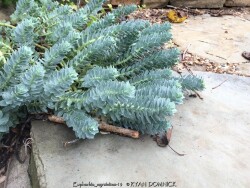

Donkeytail Spurge (Euphorbia myrsinites) is grown for its powder-blue/silver whorled foliage that is very architectural and symetrical. The stems creep along the ground in several directions from the main stem. Beautiful spring flowers are chartruse and foliage is solidly evergreen during winter and completely pest-free. Native to rocky and grassy places of southeastern Europe and Asia Minor, Donkeytail Spurge tolerates a wide range of growing conditions except excess moisture. Performance is best in poor soils, including rocky-sandy ones. Root rot can be a problem in poor drainage areas. It prefers full sun but can also grow well in full dry-shade. Individual plants tend to be short lived so allow some self seeding to occur within the group of plants. Due to self-seeding, it is considered a noxious weed in several western states and should not be planted in those areas. However, it is not a problem in Eastern Kansas or further East areas with over 35 inches of rainfall per year. Do not plant in rich moist soils or root rot will probably occur. Donkeytail Spurge is less adapted to consistent summer heat and humidity of zone 7b Southeast parts of the United States. With poisonous foliage, these plants resist deer and rabbit browsing. Wear gloves when handling this plant and avoid the milky sap. Great plant for berms or clammoring over retaining walls in hot West or South exposures in full sun or the opposite full dry-shade!
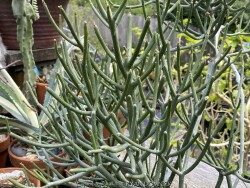

The Pencil Cactus (Euphorbia tirucalli) is a shrub with pencil-thick, green, smooth, succulent branches that provide photosynthesizes long after the foliage is shed. Usually grown as a patio or house plant in Kansas. Grow in full sun to full shade with optional extra watering including that which comes from rainfall. Plants with time to acclimate will thrive in full sun but be careful not to rush it or sunburning will occur. Generally if moving outside for the summer, allow 2-3 weeks of part shade or morning sun before placing in full sun. Repotting may or may not be needed depending on how large you want the plant to grow; plants can continue to grow taller and tolerate extremely root-bound pots but may need wind bracing. Potted plants are hardy to at least 25 degrees F for a short time if kept dry so you are ok if you miss the first light frost. Do not allow the pot with rootball to freeze solid though. Then move into a cold garage, basement, or bright window over the winter with occasional watering. As a winter house plant, it will look presentable all winter long with just a few waterings. As a permanent house plant, provide bright light and allow the soil to dry between waterings for many years of carefree enjoyment. Potted plants are very low maintenance needing very occasional pruning or topping. Stems are filled with a toxic milky sap which seems to flow out very vigorously even with only the tiniest injury. All members of the genus Euphorbia produce a milky sap called latex that is toxic and can range from a mild irritant to very poisonous.